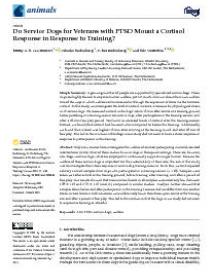Do Service Dogs for Veterans with PTSD Mount a Cortisol Response in Response to Training?
Simple Summary: A growing number of people are supported by specialized service dogs. These dogs are highly trained to improve human welfare, yet not much is known about their own welfare. One of the ways in which welfare can be measured is through the expression of stress via the hormone cortisol. In this study, we investigated the level of cortisol in saliva, a measure for physiological stress, in 19 service dogs. We measured cortisol in the dogs’ saliva 15 min after arrival at a training ground, before partaking in a training session for service dogs, after participation in the training session, and after a 45-min free play period. We found no elevated levels of cortisol after the training session.
Instead, we found that cortisol had lowered when compared to before the training. Additionally, we found that cortisol was highest 15 min after arriving at the training round and after 45 min of free play. This led to the conclusion that dogs in our study did not seem to have a stress response in response to participation in the training.
Abstract: Only a few studies have investigated the welfare of animals participating in animal-assisted interventions (AAIs). Most of these studies focus on dogs in therapeutic settings. There are, however, also dogs—service dogs—that are employed to continuously support a single human. Because the welfare of these service dogs is important for the sustainability of their role, the aim of this study was to investigate their stress response to service dog training sessions. To do this, we took repeated salivary cortisol samples from dogs who participated in a training session (n = 19). Samples were taken just after arrival at the training ground, before training, after training, and after a period of free play.
Our results showed that mean cortisol levels in all samples were relatively low (between 1.55 ± 1.10 and 2.73 ± 1.47 nmol/L) compared to similar studies. Analysis further showed that samples taken before and after participation in the training’s session did not differ from one another.
Mean cortisol levels in both situations were additionally lower than those upon arrival at the training site and after a period of free play. This led to the conclusion that the dogs in our study did not seem to experience training as stressful.
In: Animals ; ISSN: 2076-2615 | 11 | 3 | 650
https://www.mdpi.com/2076-2615/11/3/650/pdf


